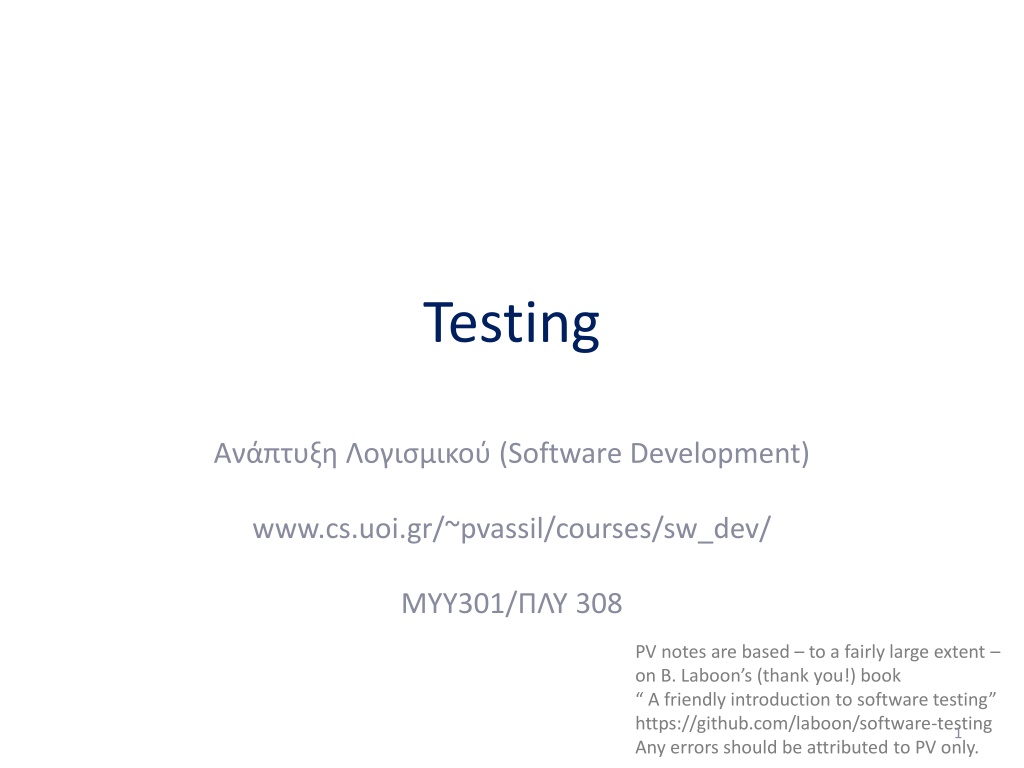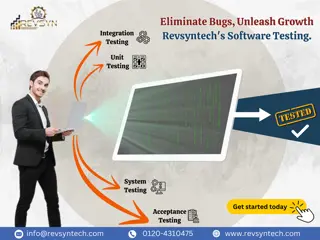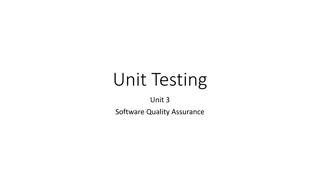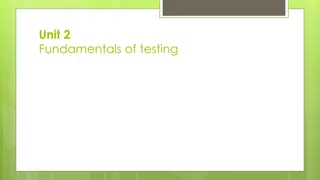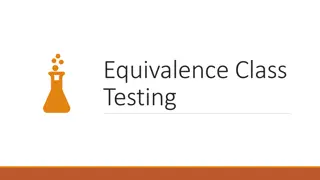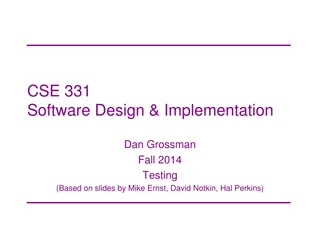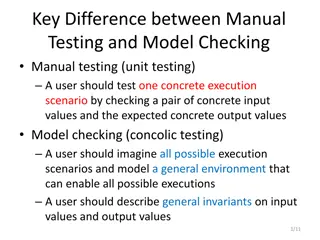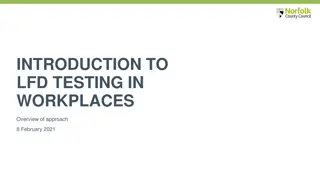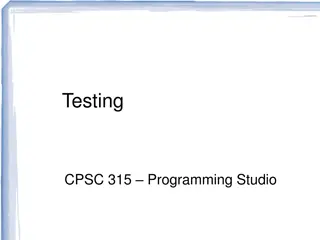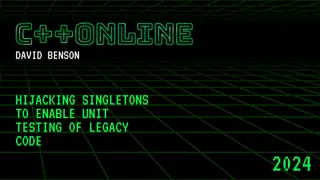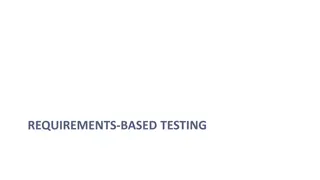Software Testing and Quality Assurance
Software testing is essential to ensure the expected behavior of a program on selected test cases. It involves dynamic verification to validate software quality and meet user requirements. Quality assurance focuses on validating observed behavior against expected results, emphasizing V&V concepts to guarantee the right software is developed with proper internal and external quality assurance standards.
Download Presentation

Please find below an Image/Link to download the presentation.
The content on the website is provided AS IS for your information and personal use only. It may not be sold, licensed, or shared on other websites without obtaining consent from the author.If you encounter any issues during the download, it is possible that the publisher has removed the file from their server.
You are allowed to download the files provided on this website for personal or commercial use, subject to the condition that they are used lawfully. All files are the property of their respective owners.
The content on the website is provided AS IS for your information and personal use only. It may not be sold, licensed, or shared on other websites without obtaining consent from the author.
E N D
Presentation Transcript
Testing (Software Development) www.cs.uoi.gr/~pvassil/courses/sw_dev/ MYY301/ 308 PV notes are based to a fairly large extent on B. Laboon s (thank you!) book A friendly introduction to software testing https://github.com/laboon/software-testing Any errors should be attributed to PV only. 1
[SWEBOK] Software testing consists of the dynamic verification that a program provides expected behaviors on a finite set of test cases, suitably selected from the usually infinite execution domain. ( , ) test cases , test case 2
Real world problem Requirements Engineering Design Requirements Specification Maintenance Design Specification Testing Implementation Working code with quality assurances Working code 3
& . ( ) & ( ) 4
Always remember: Software testing quality assurance is all about validating that the observed behavior = the expected behavior BASIC CONCEPTS 5
Software testing is Software testing is a way of providing an estimate of software quality to stakeholders (e.g., customers, users, and managers). Software testing is NOT finding every single defect. randomly pressing buttons, hoping that something will break. hoping that something will break, period. something you do after all the programming is complete. something you postpone until users start complaining. (REALLY!!) 6
V&V Software testing involves ensuring that the right software was created, with the right internal quality Verification is ensuring that you re building the software right. Verification is ensuring that the code respects coding standards, the design choices are reasonable, there are no outright blunders in the code, and the internal quality of the code is acceptable Typically, software houses employ peer developers to perform code review, a static form of code inspection in order to ensure the code is verified. Validation is ensuring that you re building the right software Validation is ensuring that the software does what the user wants. To this end, we dynamically test the code in order to find whether the external behavior of the system we have built is exactly what we have agreed with the customer in the requirements To a less extent, we can also check if there are any gaps in the requirements (so that even if the software does meet all the requirements, the user might not be satisfied with the product) 7
Defects A defect is an issue that either does not meet the system requirements or breaks the functionality of a system Observe the role of requirements here: as in all engineering projects, we need to provide guarantees on the behavior of our delivered system and thus, we validate that the system provides EXACTLY the specified functionality Naturally, crashing code is a clear case of (possibly implicitly expected) requirement violation 8
Defects Software testing quality assurance is all about validating that the observed behavior = the expected behavior 9
Nobodys perfect Software development is one of the most intellectually challenging human activities Software engineering is the discipline that imposes principle in the development of software, such that much like all engineering principles we can guarantee that the system that we produce meets quality assurance criteria and can be accepted as a deliverable to clients. 10
Nobodys perfect Everybody s code has requirement violations yours, mine, everybody s There are several techniques to validate that at least certain aspects of the system meet the specified criteria, but testing is never enough. However, the most important things to remember are 11
IMPORTANT SLIDE, EVERY SINGLE WORD MATTERS! Expand your test suite INCREMENTALLY!! The goal is NOT to test everything! The goal is to cover the most important points of risk in your code! We organize our test suite to be expanded incrementally, in a way that it is easy to expand the test suite one-test-at-a-time & run the tests fast! DO NOT LET THE FACT THAT YOU CANNOT TEST EVERYTHING INTIMIDATE YOU FROM COVERING AS MANY REQUIREMENT VIOLATONS AS POSSIBLE!!!! 12
The role of a software tester A software tester Quality Assurance (QA) Engineer does not blindly test that the software meets the requirements. Testers can be thought of as defenders of the user experience, even pushing back against other internal stakeholders to develop software which meets the needs of users instead of simply meeting the bottom line. 13
We start with a very simple scenario on testing, before dealing with the problem at a larger context A FIRST EXAMPLE ON WHITE-BOX TESTING 15
A Reference Example Test a new display for a car tire air pressure sensor, returning an integer to our software, which is responsible for activating the driver s panel We must ensure that our software correctly activates the driver s panel according to the following requirement rules: If (air pressure reading > 35 PSI) the OVERPRESSURE light should turn on If (air pressure reading is in the area of 0 to 20 PSI), the UNDERPRESSURE light should turn on If (air pressure reading < 0), the ERROR light should come on 16
A Reference Example We were told: If (air pressure > 35 PSI) the OVERPRESSURE light should turn on If (air pressure reading is in the area of 0 to 20 PSI), the UNDERPRESSURE light should turn on If (air pressure reading < 0), the ERROR light should come on 35 20 ? 0 ? 17
A Reference Example We were told: If (air pressure > 35 PSI) the OVERPRESSURE light should turn on If (air pressure reading is in the area of 0 to 20 PSI), the UNDERPRESSURE light should turn on If (air pressure reading < 0), the ERROR light should come on MININT ? 35 MAXINT ? 20 ? 0 ? Similarly for the max possible What is the min possible value? Where does 0 belong? Similarly for 20 and 35 What happens between 20 and 35? Oeo? Assume we go back to the end-user and refine req s If the pressure changes, the already lit lights turn off? Questions 18
Conveniently, the sensor returns an INT, not double Requirements refined If (air pressure in [36 .. MAXINT) ) the OVERPRESSURE light should turn on, and, all other lights should be off. If (air pressure in [0 20] PSI), the UNDERPRESSURE light should turn on, and, all other lights should be off. No light comes on for PSIs in [21 .. 35] (inclusive) - normal operating conditions If (air pressure in (MININT .. -1] ), the ERROR light should come on, and, all other lights should be off. 19
Good requirements Complete. Nothing is missing Here: we had an entire range missing + what happens to other lights Unambiguous. There are no terms like stuff , this one , . Includes quantified too. Here: the area around 0 to 20 ?? Should have been EXPLICITLY stated as [0 .. 20] Better say price = 0, than free . Consistent. What if UNDERPRESSURE in [0 .. 20] NORMAL in [20.. 30] ? 20
We partition the range of values to equivalence classes An equivalence class (also called an equivalence partition) is one set of input values that maps to an output value. If no overlap of classes: strict partition If there is no spec for a partition: undefined We had 2 cases of undefined behavior in our example: The range [21 .. 35] What happens with each and every light at each equivalence class 21
Boundary & Interior values Boundary values: the last of one equivalence class and the first of a new equivalence class. Values which are not boundary values are called interior values. Implicit boundary values: due to the specificities of the system under test or the environment under which the system operates. E.g., MAXINT and MININT are system dependent Max size of a collection Math properties: div by 0, sqrt(-1), 22
How to test with equivalence classes Ideally, all boundary values and a good sample of interior values In our example, values to test: 1. Interior values, ERROR: -3, -100 2. Boundary values, ERROR / UNDERPRESSURE: -1, 0 3. Interior values, UNDERPRESSURE: 5, 11 4. Boundary values, UNDERPRESSURE / NORMAL: 20, 21 5. Interior values, NORMAL: 25, 31 6. Boundary values, NORMAL / OVERPRESSURE: 35, 36 7. Interior values, OVERPRESSURE: 40, 95 23
Test cases Base case: a value in an equiv. class that is not near the boundary Happy path - a case with valid, usual input where no problems occur. Edge case: a value at the boundary, or, an unexpected case Pathological case: value completely out of the specified domain (e.g., you expect an int and you get a string or an imaginary number) 24
IMPORTANT SLIDE! Why important? ALWAYS test the happy path of a use case! Even if you don t test anything else, this is the minimum testing you need Boundaries (=> edge cases) are prone to creating problems because of the if(), <, <=, typically involved Catastrophic cases: things can always go wrong with the input invalid input null pointers 25
For you. Case #1 Bus ticket prices: For children under 2: free For children older than 2 but under 18: 1$ For senior citizens, 65 or older: 1$ All else: 2$ Can you spot problems? 26
For you. Case #2 Pizza discounts at the Undergraduate students: 20% discount Grad students: 30% TA s: 10% TA is orthogonal to grad/ugrad; can also be non- student personnel Grad/ugrad are mutually exclusive Discount is additive (e.g., ugrad TA gets 20% + 10% = 30% discount) 28
For you. Case #3 The shopping cart. An online store provides each registered customer with a shopping cart. The customer can Add a number of items to the cart (e.g., 3 t-shirts) Remove a number of items from the cart You can always add a new item at a cart, at any integer quantity greater than zero If you want to add an item at a cart that already exists, the respective qty must be increased If you want to remove a quantity of an item from the cart, (a) the item must exist in your cart, (b) the removed quantity must be <= the qty that already exists Before and after every operation, the list of items and their qty s are displayed to the user 29
Always remember: Software testing quality assurance is all about validating that the observed behavior = the expected behavior BASIC CONCEPTS RELOADED 30
IMPORTANT SLIDE! Actual = Expected Behavior? Test code to assess MyClass.doSth() Src code of MyClass.doSth() Specific input Specific prior-state Diff between expected and actual behavior Testing Facility (runs the code with given input and prior state) Expected output if (diff == 0){ expected and actual behavior coincide; test is a success; } Expected post-state Actual output Actual post-state 31
Test execution When we run a test, there are several potential outcomes. The most typically encountered are: Test passed: the test execution produces a pair { output + post-conditions } which is identical to the respective expected one Test failed: at least one part of the actual behavior differs from the respective expected one Test crashed (a.k.a. error): the test did not complete normally, typically without producing an actual output. 32
Yes, but how to define which tests? (coming soon) Black-box testing: tester is agnostic to the internals of the source code, just based on the relationship of input expected actual output White-box testing: tester is based on source code structure, trying to cover the most important execution paths of the source code Code Review (executed by peer developers) is NOT white-box testing: code review is a static inspection of the code, to uncover obvious defects, possibly in the style and structure of the code; testing is a dynamic execution of the system, where the actual behavior of the system is compared to the expected one 33
Happy Path Reloaded The happy path / happy day scenario is: For system tests, concerning use cases: the primary flow = zero-problem execution of a use case For simple tests, e.g., unit tests of specific methods: the case where input is valid, no problems occur and the execution terminates successfully ALWAYS TEST THE HAPPY PATH! 34
PLANNING TESTS: STRUCTURING TEST CASES 35
Test plan A test plan is a collection of test cases, aimed towards ensure that a certain requirement is met A test case is a combination of Code to be tested Input values Expected output Pre- and post- conditions For every test plan we have several test cases We also have a principled, structure way of producing test plans (see next) 36
Elements of a test case Identifier: An identifier, such as T1_V1 , 16 , DB-7 , or DATABASE- TABLE-DROP-TEST , which uniquely identifies the test case. Test Case Description: a structured description of the test case and what it is testing. Preconditions: Any preconditions for the state of the system or world before the test begins. Input Values: Any values that we input directly to the test. Expected Output Values: Any values directly generated as output by the execution of the test case. Postconditions: Any postconditions of the state of the system or world which should hold true after the test has been executed. Method(s) to test: the method(s) whose output is to be asserted for correctness (if known at the design of the test else omit) Other: Execution steps. Detail execution steps if need Comments. 37
Id Description Preconditions Input Postconditions Output Identifier A unique string to uniquely characterize a test case among its peers. In the context of this course we will introduce two possible versions: A short version, denoting the family of similar test cases to which it belongs + a unique identifier within the family A long version, appending a short textual description 38
Identifier Assume you have two use cases: - UC1: executePurchase - UC2: registerNewUser Now we want to create a test plan that includes use cases for them. We will test the happy day case for each of them, plus Variants with invalid input. We assign the following Identifiers - SHORT: We rank each family of test cases with a family id that corresponds to the respective use case (first part of the short id) and an increasing integer for the variant (second part of the short id). - LONG: we append a string with the description of the use case and a description of the variant Unless otherwise specified, all references to the use case are expected to use just the short version Short Long T1_V0 T1_V0_executePurchase_HappyDay T1_V1 T1_V1_executePurchase_WO_Login T1_V2 T1_V2_executePurchase_WO_Money T2_V0 T2_V0_registerNewUser_HappyDay This is just a naming scheme adopted for this course. In practice this can vary a lot. T2_V1 T2_V1_registerNewUser_invalidInput 39
Id Description Preconditions Input Postconditions Output Test case description: OREOS A sentence in the format ON a context/pre-existing state of the system RECEIVING a certain input/event, ENSURE THAT THE SYSTEM OUTPUTS such and such an output, SUCH THAT its posterior state is such and such precondition input output IMPOSE the OREOS rigorous structure to your description!!! postcondition 40
Methods & Test case description At the end of the day, we end up testing methods (not classes, not packages, -- it all boils down to testing methods) Be it simple methods or methods pertaining to entire use cases: try to express the method s essence as an OREOS statement 41
OREOS Examples Ensure that on-sale items can be added to the cart and will have their price automatically reduced. T5_V1 a cart having being assigned to a customer (absent from the spec. text) ON RECEIVING on-sale items to be added to the cart ENSURE OUTPUTS SUCH THAT the cart is filled with the added items with their price automatically reduced THAT THE SYSTEM an updated cart 42
OREOS Examples Ensure that passing a non-numeric string as input will result in the square root function throwing an InvalidNumber exception. T123_V2 any context ON RECEIVING a non-numeric string as input ENSURE THAT THE SYSTEM throwing an InvalidNumber exception. OUTPUTS SUCH THAT state is intact 43
OREOS Examples When the system detects that the internal temperature has reached 150 degrees Fahrenheit, ensure that it displays an error message and shuts down within five seconds. T45_V99 any context ON RECEIVING a signal that the internal temperature has reached 150 degrees Fahrenheit ENSURE THAT THE SYSTEM displays an error message OUTPUTS SUCH THAT the system shuts down for 5 44
OREOS Examples Ensure that if the operating system switches time zones midway through a computation, that computation will use the original time zone when reporting results. T6_V0 The O/S being in the context of a computation ON RECEIVING A signal of time zone switching ENSURE THAT THE SYSTEM the results, having used the original time zone OUTPUTS SUCH THAT state is intact 45
Id Description Preconditions Input Postconditions Output Input and Output Identifier: An identifier, such as T1_V1 , 16 , DB-7 , or DATABASE- TABLE-DROP-TEST , which uniquely identifies the test case. Test Case Description: a structured description of the test case and what it is testing. Preconditions: Any preconditions for the state of the system or world before the test begins. Input Values: Any values that we input directly to the test. Expected Output Values: Any values directly generated as output by the execution of the test case. Postconditions: Any postconditions of the state of the system or world which should hold true after the test has been executed. Method(s) to test: the method(s) whose output is to be asserted for correctness (if known at the design of the test else omit) Other: Execution steps. Detail execution steps if need Comments. Once the description is structured, be specific on these!! 46
Input and Preconditions Think of Pre-condition: a STATE of the system that has to be present for the test to apply Input: think of it as method input parameters, i.e., values Output: think of it as method return value (although not necessarily so) Post-condition: the STATE after completion In our minds: we can think of a state as a set of Boolean conditions that must hold! If a test applies anyway, no pre-condition (default value: any context ) If there is no effect to the state of the system, no post condition (default value: state is intact ) Input != Precondition (similarly for out-/post-) Input is sth given by another s/w module or the user for the purpose of the tested method Pre-cond is a setup of the objects/vrbl s & their states of the runtime 47
Methods to test && how to build both the method and its test code It is methods that we test. Remember: we give input and expected output and assert that the actual output is identical to the expected one! Checklist on how to structure the source code of the method in a way that it is testable: Pass all input to a method as method parameters Produce a return value as either the output (if the output is an object) or a description of the output (e.g., if the output is a file, return a string with its path) Checklist on how to build the code of the test : The pre-existing state of the system should be created via the appropriate new() of the appropriate objects The resulting state of the system would require that the object whose method we test holds the state, or that the affected objects are created via the new() calls and participate in the method s execution 48
States and values Input != Precondition (similarly for out-/post-) Input is sth given by another s/w module or the user for the purpose of the tested method Pre-cond is a setup of the objects/vrbl s & their states of the runtime We can think of pre- and post- conditions as states; we can think of a state as a set of Boolean conditions that must hold! In the case of the Happy Path: the call is made only if the pre-condition state holds In the case of Alternative Variants: we might intentionally create offending states, to check whether the code will detect them 49
States and their Boolean expression State Boolean correspondence a cart having being assigned to a customer Boolean isCartAssignedToCustomer(); The O/S being in the context of a computation Boolean isOSInComputationContext(); The code of each such method depends on the values of the attributes of one or more collaborating objects! 50
Example of the design of a simple test //We want to split a time line in phases & invoke an analyser to do it ID T2_V0_01 HappyDayScenario for NaiveAnalyser Description ON any context RECEIVING Request to analyze a valid timeline into phases ENSURE That the System OUTPUTS a set of phases SUCH THAT state is intact Pre-cond. Load input_test.txt, a small file with less than 10 entries, all valid, for o(5) phases, and produce a timeline the abovementioned produced timeline Input Output A correct #phases, with the correct points inside Post-cond. No state properties tested NaiveAnalyser.producePhasesFromTimeLine (TimeLine) Method To test 51
